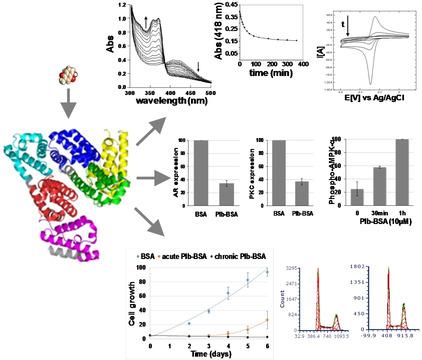当前位置:
X-MOL 学术
›
ChemMedChem
›
论文详情
Our official English website, www.x-mol.net, welcomes your
feedback! (Note: you will need to create a separate account there.)
Plumbagin-Serum Albumin Interaction: Spectral, Electrochemical, Structure-Binding Analysis, Antiproliferative and Cell Signaling Aspects with Implications for Anticancer Therapy.
ChemMedChem ( IF 3.6 ) Pub Date : 2020-05-14 , DOI: 10.1002/cmdc.202000157 Adrian Chrastina 1 , John Welsh 2 , Gaelle Rondeau 2 , Parisa Abedinpour 1 , Per Borgström 2 , Véronique T Baron 2
ChemMedChem ( IF 3.6 ) Pub Date : 2020-05-14 , DOI: 10.1002/cmdc.202000157 Adrian Chrastina 1 , John Welsh 2 , Gaelle Rondeau 2 , Parisa Abedinpour 1 , Per Borgström 2 , Véronique T Baron 2
Affiliation

|
Plumbagin (5‐hydroxy‐2‐methyl‐1,4‐naphthoquinone) is a small molecule with potent anticancer activity. Like other 1,4‐naphthoquinones, it exhibits electrophilic reactivity towards biological nucleophiles. We demonstrate that plumbagin and structurally related 1,4‐naphthoquinones with at least one unsubstituted quinoid carbon (C2 or C3) bind to albumin, an ubiquitously present nucleophile, with minimum recovery of free drug. Extraction recovery of plumbagin from albumin in solution showed one‐phase exponential decline with a half‐live of 9.3 min at 10 μmol/L. In the presence of albumin, plumbagin exhibited instant changes in UV /V is absorption bands. Electrochemical analysis using cyclic voltammetry showed a decrease in redox peak currents over time until electro‐inactivity, thus suggesting the formation of a supramolecular adduct inaccessible for electron transfer. The adduct inhibited cell growth and caused cell‐cycle arrest of prostate cancer cells, in part by decreasing levels of the cell‐cycle regulator RBBP. The conjugate displayed similar cellular effects to those described for plumbagin, such as decreased levels of androgen receptor and protein kinase C epsilon. The effect of plumbagin‐albumin on cancer cells was species‐specific, suggesting a receptor‐mediated mechanism. Furthermore, it was blocked by cathepsin inhibitor pepstatin A, indicating that lysosomal degradation is involved in the processing of plumbagin‐albumin adduct. The spontaneously formed adduct of plumbagin with serum albumin is likely to mediate the biological activities of plumbagin in vivo and to fundamentally influence its pharmacodynamics.
中文翻译:

Plumbagin-血清白蛋白相互作用:光谱,电化学,结构结合分析,抗增殖和细胞信号方面具有抗癌治疗的意义。
Plumbagin(5-羟基-2-甲基-1,4-萘醌)是一种具有强效抗癌活性的小分子。像其他1,4-萘醌一样,它对生物亲核试剂表现出亲电反应性。我们证明了plumbagin和与结构相关的1,4-萘醌与至少一个未取代的醌碳(C2或C3)结合白蛋白(一种普遍存在的亲核试剂),游离药物的回收率最低。从溶液中的白蛋白中提取李子苷的回收率呈单相指数下降趋势,在10μmol/ L时半衰期为9.3分钟。在白蛋白存在下,李白蛋白的U V / V表现出瞬时变化是吸收带。使用循环伏安法进行的电化学分析显示,氧化还原峰电流会随着时间的推移而降低,直到电不活动为止,因此表明形成了电子转移难以到达的超分子加合物。该加合物抑制前列腺癌细胞的细胞生长并引起细胞周期停滞,部分原因是细胞周期调节剂RBBP的水平降低。该缀合物显示出与针对铅球素所描述的那些相似的细胞作用,例如降低的雄激素受体和蛋白激酶Cε水平。李白蛋白白蛋白对癌细胞的作用具有物种特异性,提示受体介导的机制。此外,它被组织蛋白酶抑制剂胃抑素A阻断,表明溶酶体降解与李白蛋白-白蛋白加合物的加工有关。
更新日期:2020-07-20
中文翻译:

Plumbagin-血清白蛋白相互作用:光谱,电化学,结构结合分析,抗增殖和细胞信号方面具有抗癌治疗的意义。
Plumbagin(5-羟基-2-甲基-1,4-萘醌)是一种具有强效抗癌活性的小分子。像其他1,4-萘醌一样,它对生物亲核试剂表现出亲电反应性。我们证明了plumbagin和与结构相关的1,4-萘醌与至少一个未取代的醌碳(C2或C3)结合白蛋白(一种普遍存在的亲核试剂),游离药物的回收率最低。从溶液中的白蛋白中提取李子苷的回收率呈单相指数下降趋势,在10μmol/ L时半衰期为9.3分钟。在白蛋白存在下,李白蛋白的U V / V表现出瞬时变化是吸收带。使用循环伏安法进行的电化学分析显示,氧化还原峰电流会随着时间的推移而降低,直到电不活动为止,因此表明形成了电子转移难以到达的超分子加合物。该加合物抑制前列腺癌细胞的细胞生长并引起细胞周期停滞,部分原因是细胞周期调节剂RBBP的水平降低。该缀合物显示出与针对铅球素所描述的那些相似的细胞作用,例如降低的雄激素受体和蛋白激酶Cε水平。李白蛋白白蛋白对癌细胞的作用具有物种特异性,提示受体介导的机制。此外,它被组织蛋白酶抑制剂胃抑素A阻断,表明溶酶体降解与李白蛋白-白蛋白加合物的加工有关。











































 京公网安备 11010802027423号
京公网安备 11010802027423号